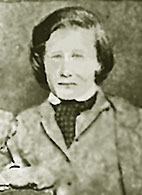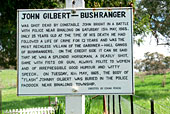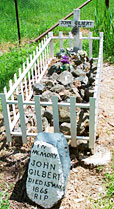John was born in Canada in 1842, the youngest son of seven children. His English parents, William James Gilbert and Eleanor nee Wilson, had emigrated to Canada from London in 1830. Shortly after John's birth, Eleanor passed away, and William remarried a Canadian woman of almost half his age, Eliza Cord.
In 1852, following the news of the discovery of gold in Australia, the family decided to migrate and arrived at Port Phillip on the ship "Revenue". Young John was only twelve, when he left home and worked as a stableman in Kilmore (Victoria). At eighteen he was rumoured to have found his way to the Kiandra goldfields and later worked as a stockman at Marengo in New South Wales. He soon became popular among the young scoundrels in the Weddin Mountains District who preferred stealing, gambling and fighting to hard work.
At this time, he fell under the influence of the bushranger who used the alias "Frank Gardiner". (Francis Christie PW) John was usually described as quite a smart man who could read and write, and a very jolly fellow who was always laughing. It was because of his happy disposition, that John was nicknamed "Happy Jack". He was also of thin slight build, and an excellent horseman.The tragedy of his life was that he became a bushranger - a criminal by choice.
In 1862, John Gilbert was first named as an accomplice of Gardiner when they and two others held up Alfred Horsington, storekeeper, and his wife, and two others. After relieving them of £145 in cash, 253 ounces of gold and some other items, they went on their way. Just over a month later, John Gilbert was involved in another robbery, this time with Gardiner, a young squatter named Ben Hall, and another named John Youngman. From then on John Gilbert was identified as being involved in several hold-ups including a carrier, William Bacon and his two drivers between Lambing Flat (Forbes) and Lachlan, Mr H Herbert's store at Little Spring Creek, and the store of Henry G. Chard.
Over the preceding months, Frank Gardiner had been considering the idea of attacking the Forbes gold escort. After formulating a plan, he now decided to put it into action at a place called Eugowra Rocks. Enlisting the assistance of John Gilbert, Ben Hall, John O'Meally, Dan Charters, Henry Manns, Alexander Fordyce and Johnny Bow, they purchased all the equipment necessary including six double-barrel shotguns, and finally set off for Eugowra. The gang arrived in the evening of June 14th, 1862, and camped the night. Early next morning Gardiner loaded all the longarms with about seven revolver balls in each barrel, while the others experimented with blacking their faces and other methods of disguising themselves. It was around 3.00pm, when the robbers left their horses about a mile from the Eugowra Rock and walked the rest of the way on foot. Not long after arriving, two horse-drawn wagons came along the road and were consequently bailed up. Their drivers were ordered to place their vehicles across the road to block it, and then lie under the wagons. At around 5.00pm the bushrangers were keenly waiting as the Forbes gold escort coach came into view. As the driver slowed down to drive the coach around the two vehicles blocking the road, Frank Gardiner suddenly said "Fire". Without any warning, all men except Fordyce, who appears to have been drunk, fired their guns at the gold escort. By a sheer miracle no one was killed as at least 10 balls smashed through the coaches woodwork. The driver luckily had one go through his hat and another through his coat. Two of the police were wounded, Sergeant Condell in the side, and Constable Moran in the testicles. One of the horses was hit in the leg by a ball, causing the rest of the animals to bolt into the rocks where the vehicle overturned. Helping their wounded, the troopers were forced to withdraw, leaving the gold to be plundered by the bushrangers. This was the biggest robbery in bushranging history in Australia, with the criminals netting some £14,000 in gold and cash. The gang took their haul to Gardiner's campsite on Mt Wheogo, which was about sixty miles from the hold-up, and the proceeds were equally divided up. The party then split up, with Ben Hall, John O'Meally and Henry Manns going home, leaving the rest at the campsite. Three days later the remaining gang members decided to leave, but first they needed a pair of saddle-bags to carry the loot.
As young Johnny Gilbert was fetching them, he was spotted by Senior-Sergeant Charles Sanderson and a blacktracker, who gave chase. Gilbert led the police straight to the camp. The gang hurriedly took off but the pack-horse laden with half the gold could not travel fast enough, and Gardiner was forced to turn him loose and later from hiding watched, as a trooper caught the animal. After escaping, Johnny Gilbert laid low for a while and then decided to leave the colony. But as he, his brother Charles, and Henry Manns were leaving on July 7th, they came face to face with a party of police out looking for the robbers. Sir Frederick Pottinger, the leader of the police party, asked the men if they had receipts for their horses, which was usual for that time. As young Gilbert started to feel in his waistcoat pocket, he deliberately dropped his reins, and whilst acting as if he was trying to pick them up, slowly edged his horse further into the scrub at the side of the road. Suddenly he grabbed the reins and galloped off into the bush, making his escape, leaving his mates under the threat of being shot, if they attempted the same. Meanwhile, Johnny Gilbert took off to O'Meally's shanty to enlist help to free his mates, and returned with five men including, Gardiner, O'Meally and Hall.
They bailed up the police party, and after some heated exchanges of gun fire managed to release their two mates. Johnny Gilbert, still carrying his share of the reward, about £2500, joined his brothers Charles & James, and together they travelled to Victoria and then on to the gold fields of New Zealand. The hard life of a gold-miner did not suit Johnny Gilbert, and within five months he made his way back to New South Wales. After forming a gang of his own, the young twenty two year old now committed murder - he shot dead a mounted policeman, Sergeant Edmund Parry, while committing robbery under arms.
Gilbert who had a £1000 reward on his head for his part in the escort robbery, was now proclaimed an outlaw - but by then he had only one more year to live. He was shot by the police at the bank of the Billabong Creek on 13th May 1864. At the time of his death he had become Australia's worst criminal, being involved in more than 630 hold-ups, a record that not even his counter-parts during the "wild west era" in the United States of America can equal. After the inquest, he was buried in the paddock of the Binalong police station on the 16th May 1864.

Johnny Gilbert

Sign near the grave

John Gilberts grave at Binalong
A sign near the grave reads
"JOHN GILBERT - BUSHRANGER
Was shot dead by Constable John Bright in a battle with police near Binalong on Saturday, 13th May, 1865.
Only 25 years old at the time of his death he had followed a life of crime for 12 years and was the most reckless villain of the Gardiner-Hall gangs of bushrangers.
On the credit side it can be said that he was a splendid horseman, a deadly shot, game with fists or gun, always polite to women, and of irrepressible good humour and witty speech.
On Tuesday 16th May, 1865, the body of 'Flash' Johnny Gilbert was buried in the police paddock near Binalong township.
Erected by Edgar Penzig."
